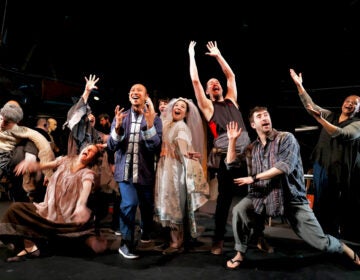Spying in Philadelphia gets a close look at Franklin exhibit
An incredible amount of information is gathered about you every day through credit cards, Internet traffic, and cell phones, most of it without your knowledge or consent. So much, and so quickly, that it’s almost quaint to step back into a world where covert information changed hands via the body cavity of a dead rat.
“Spy: The Secret World of Espionage,” the new exhibition at the Franklin Institute, comprises items from the collection of H. Keith Melton, an engineer and historian who has been collecting spy-related objects for 40 years, mostly 20th-century leftovers.
“World War II was the first global intelligence war. You needed lots of agents. You didn’t need one spy radio, you needed a thousand. So we started assembly lines to produce clandestine gadgetry,” said Melton. “The British, the Russians, Germans, Americans mass-produced spy equipment. It was possible to find examples.”
Shoes with false soles for carrying microfilm. An original Enigma code-breaking machine. A robotic catfish. A cross-section of poured-concrete pillars from a former U.S. embassy building in Moscow that was embedded with electronic bugs.
And the dead rat. Agents would stuff the body cavity of a dead rat with written intelligence, then nonchalantly toss them out the window of a speeding car, where another agent would retrieve it.
The problem: Moscow’s feral cats would get to the rat first.
The solution: Dip the carcass in hot sauce.
“The goal never changes,” said Melton. “Technology changes the way we do it, but we still just want one thing. Our leaders need information to make good decisions.”
Two centuries of espionage in Philly
Melton worked with a former director of CIA technical services, Robert Wallace, to put together a book, “Spy Sites of Philadelphia,” the second of a series of city-specific tour books. (The first was about New York, where the museum exhibition originated.)
The sites span nearly 240 years of espionage in Philadelphia, started with intelligence-gathering during the Revolutionary War. One of the few remaining buildings still standing is Headhouse Square on South Street. During the British occupation of the city, patriot spies would enter the city disguised as farmers coming to sell produce in the market, where they would hand off information. (Coincidentally, the farmers’ market at Headhouse Square reopens for the season this weekend.)
During World War II, the pastor of St. Michael’s Lutheran Church in Mount Airy was convicted of conspiracy. The German veteran of World War I aided German spies in Philadelphia. He and his conspirators were caught by an FBI agent posing as a priest.
At the same time, a Russian agent had infiltrated the Navy Yard, where secret military atomic research was being conducted in Building 638 for the Manhattan Project. The spy, George Koval, codename DELMAR, was never caught. The U.S. only learned of Koval 60 years later, in 2007, when Russian President Putin honored him posthumously as a hero of the Russian federation.
“That’s a fascinating total-espionage case, how they were able to find agents and place people in Oak Ridge [Tennessee], Los Alamos [New Mexico], and here at the Navy Yard,” said Wallace. “Wherever there was a piece of the Manhattan Project, the Russians tried to place agents to report what was going on.”
James Bond would be shaken in real world
Visitors to the exhibition might marvel at some of the objects Melton has been able to acquire privately, including a piece of the U-2 spyplane that famously crashed in the Soviet Union in 1960 and a crumpled piece of Pan Am Flight 103, which exploded over Lockerbie, Scotland, in 1988. How on earth did he get this stuff?
The grisliest object is the ice ax used to kill Leon Trotsky in Mexico City, splotched with rust from the Marxist’s blood. Walking through his exhibition, Melton carefully explains that death is the exception in the intelligence game, not the rule.
“James Bond wouldn’t last four minutes in the real world,” said Melton. “Everything Bond does is fun to watch, but it’s not practical in the real world. Intelligence officers are the ones that blend in the crowd, the ones that you never see. Intelligence is not killing people, it’s getting information.”
WHYY is your source for fact-based, in-depth journalism and information. As a nonprofit organization, we rely on financial support from readers like you. Please give today.








